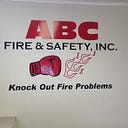How can we use a Fire Extinguisher to help in an emergency situation?
Business owners know how important it is to have the right types and number of fire extinguisher at work. They also need to ensure that the equipment is regularly serviced and checked. Are you certain that your employees have the right training to manage an emergency situation in case of a fire?
If the fire is small and can be isolated quickly, fire extinguisher or other fire safety equipment should be available for use by employees.
It is crucial that employees are able to identify the correct extinguisher and how to use it in this situation.
Fire Safety Training
Specialist companies who conduct fire safety training recommend that the PASS method be used as a simple way to remember what to do. PASS stands as:
Pull To operate the extinguisher, you first need to pull the safety pin/tag.
Aim: You should aim the extinguisher towards the fire’s source.
Squeeze: Press the trigger slowly and steadily to activate the extinguisher.
Sweep: You will need to sweep the extinguisher around the flames’ base until it is completely out of commission.
Different types of workplace extinguishers
Different types of extinguishers are effective for different fire types. It is important that you have the correct extinguisher to put out the fire. You could also spread the fire rather than putting it out if you choose the wrong extinguisher.
These are the main types of fire extinguishers that are most commonly used at work:
Class A fires are for combustible materials that are caused by flammable solids like wood, paper, or textiles
Class B Fires for flammable liquids like petrol, paint, or spirits
Class C fires for flammable gases like propane and butane
Class D fires are for flammable metals, including chemicals like magnesium, lithium, or potassium
Electric fires are used to heat electrical equipment such as photocopiers and computers.
Cooking oils such as butter and olive oil can be prepared in Class F fires. A chip-pan fire is the most common.
This table gives you an overview of the types of extinguishers you will need for various fires.
Information on the Different Types of Fire Extinguishers
We thought it would be useful to share some information with you about the extinguishers we sell to UK businesses.
● Water-Fire Extinguishers: This type of extinguisher expels water directly from the fire. Be aware of potential electrical hazards like computers and copiers. Avoid contact with the extinguisher’s water.
● Foam Extinguishers — These extinguishers contain strong chemical elements that can make them dangerous in certain environments.
● Powder Fire Extinguishers: The main problem with a powder extinguisher, is that it tends to get everywhere. It should be removed as soon as possible.
● Co2 Extinguishers — Co2 is a dangerous gas. The presence of co2 in an extinguisher can cause a shortage of oxygen. It is important to evacuate the area immediately before the designated person uses the extinguisher.
Wet Chemical Fire Extinguishers are great for kitchens and restaurants, as they can be used on oils and fats. These extinguishers can cause oil to spit out if it isn’t used with care.
